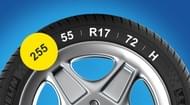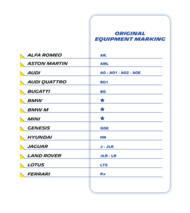
Tips & Advice for Car, SUV & Van tires
Is it time to replace my tires?
How to read tyre codes?
What car tires do I need?
How to choose the best car tires?
If you are asking yourself these questions, our article will help you to consider the important criteria for making the right choice.
How do you know when the tires need replacing?
Understand the lifespan of a tire
Before fitting new tires to your car. The first thing you need to know is how long do tires last because it’s recommended that you keep on using the current tires until the last mile for maximum efficiency and to reduce the environmental impact. You might have heard from friends that tires should be replaced every 3 years but we suggest otherwise.
The interval for tire replacement is not standardized and varies based on several factors, including the type of tires, driving habits, frequency of use, and maintenance practices. Nevertheless, it is advisable to have tires inspected by a qualified professional annually after 5 years of service. This recommendation applies even if the tires seem to be in good condition and have not reached the tread wear indicator. The same advice also applies to spare tires.
Please consider replacement before they reach the ten-year mark from their date of manufacture, which is considered the upper limit.
How to determine the age of a tire?
Each tire has a DOT (U.S. Department of Transportation) identification number printed on the sidewall. This code reveals its manufacturing date containing four digits, with the first two indicating the week and the latter two indicating the year of manufacture. By decoding this information, you will know the age of your tire.
For example, in the tire DOT code shown here, this tire is manufactured in the 47th week of 2014.

How long do Michelin tires last?
You can enjoy using our tires which are made to last for a very long time. Specifically, MICHELIN warranty shall be for the life of the original usable tread pattern or 6 years from the date of purchase, whichever comes first. You can read more about our warranty policy here.
In addition to the longevity, we promise that our tires will deliver you more responsive braking, better grip, and more satisfying overall driving experience.
How do I know what tire size I need?
The tire size might seem to be the only important factor in deciding which tire supply to buy. However, as we will see, it is also essential to take into account your driving style. To help you make the right choice, we'll also mention the European labelling system and provide you with a decision-making tool before seeking a tire supplier in Philippines.
As a tire does not have a standard size, you must first identify the tire sizes that are compatible with your vehicle before making your choice according to the other criteria that we will explain below.

Where can I find the tire sizes for my car?
Look at the sidewall of any one of your tires and note the numbers and letters on it.
This information will help you find the tires that fit your car.
Here is an example of the complete dimensions of a tire: 255/55 R17 72H
You can also find the tire sizes in your driver or passenger door
Tire sizes are also listed in your vehicle's owner's manual (which you should find in the glove compartment). These documents usually contain all the information relating to your tire size and specifications, as well as the appropriate tire pressure.

How to read tyre codes
What do these letters and numbers mean?
Tire Width or Section Width: (Example : 255)
Tire width in millimetres is measured from the widest point of a tire’s outer sidewall to the widest point of its inner sidewall. Tire width is a crucial factor influencing your car's performance. Wider tires offer advantages in grip, handling, and stability. However, it comes with trade-offs in fuel efficiency and comfort.
Aspect Ratio: (Example: 55)
Aspect ratio is the relationship between a tire’s sidewall height and the tire's width. The lower the ratio, the smaller the sidewall height, which means better cornering but a rougher ride.
Construction: (Example: R)
This indicates the tire’s internal construction. They can be R (Radial) like most tires, or D (Diagonal construction) or B (Belted).
Wheel Diameter: (Example: 17)
The number is in inches and indicates the diameter of the wheel on which the tire is designed to fit.
Load Index: (Example: 72)
This indicates how much weight the tire is certified to carry at maximum safe inflation. The numbers refer to a chart that specifies the load capacity that the tire supply can carry.
For example, 72 = 355 kg.
You can find yours in the load Index chart:
Speed Rating chart: (Example: H)
This indicates the maximum safe speed at which a tire is certified to carry a load under specified conditions. Speed ratings range from A (lowest) to Y (highest), with one exception: H falls between U and V.
For example, H = 210 km/h.
To find the maximum speed for your tire, refer to the speed rating chart. Exceeding the lawful speed limit is neither recommended nor endorsed.

High load Capacity tires (HL tires)
HL tires are designed to support the weight of Electric & Hybrid vehicles. They allow to use the same tire size but with higher load-carrying capacity.
How to recognize a HL tire? Thanks to the HL prefix located at the beginning of the tire size.
What are OE tires?
OE stands for “Original Equipment”, meaning that the tires were approved by your vehicle manufacturer to be fitted as standard on your vehicle.
Some vehicle manufacturers, such as Audi, BMW, Mercedes, and others, equip their vehicles with tires that are specifically designed for their brands. These tires have a special OE marking on the sidewall. In this case, MICHELIN recommends replacing the tires on your vehicle with tires with the specific OE marking.
Table of OE markings by vehicle brand:



Additional information about how to read tyre codes can be found here.
You can learn more about tire pressure, care, and maintenance in our FAQ.
Can I change my tire size?
Yes, you can customize tire size to better suit your needs and preferences, but it is generally not recommended without careful consideration. Discover the following advantages and disadvantages of altering the tire size from the original specifications for your vehicle to understand it more clearly.
Larger tires
Advantages:
- Improved performance: Larger tires can improve traction, handling, and braking performance, particularly in off-road or high-performance scenarios.
- Ground clearance: They can provide additional ground clearance, beneficial for off-road driving or navigating uneven terrain.
- Aesthetic appeal: Some people prefer the look of larger tires, as they can give the car a more aggressive or sporty appearance.
Disadvantages:
- Decreased stability: Larger tires can affect the car's suspension and handling, potentially leading to a rougher ride.
- Fuel efficiency: They can increase rolling resistance, which leads to decreased fuel efficiency.
Smaller tires
Advantages:
- Improved acceleration: Smaller tires can improve acceleration by reducing the overall weight and rolling resistance of the vehicle. They can also improve handling and maneuverability, especially in tight spaces or when parking.
- Improved ride comfort: They can provide a smoother ride, especially on rough roads, due to their increased sidewall height, which can absorb more bumps and shocks.
- Cost savings: They are often less expensive to purchase and maintain.
Disadvantages:
- Braking performance: Smaller tires may have slightly longer braking distances due to their reduced contact patch with the road.
- Reduced traction: Smaller tires may offer less traction, especially in wet or slippery conditions, due to their narrower tread width.
Safety first
In some regions, changing tire size are illegal or requires specific modifications to maintain safety standards. Changing tire size can also affect the accuracy of your speedometer and odometer readings, which may lead to legal issues.
As a result, before upsizing or downsizing tires, it’s critical to consult with a tire specialist to determine the compatibility of the new tires with your car, ensuring that they won’t negatively impact your car's performance and safety, as well as preventing potential legal issues such as a refusal to have your vehicle inspected by the transportation officers, not being covered by your insurance in the event of an accident, and a fine in the event of a police check, for example.
Additional information about changing tire size can be found in this guide here.
How to choose the right tyres for your car usage
Once you have the correct dimensions, there are two other criteria to consider:
- your driving style
- the type of engine (electric or thermic)
Your driving style:
To make sure that you enjoy your drive, look for tires that match the way you like to drive.

If you prefer a quiet, comfortable ride:
Look for tires that specifically mention comfort, smooth ride, or low road noise for a more peaceful driving experience and less fatigue.
Generally speaking, touring tires with lower speed ratings (S, T, or H ratings on the sidewall) are optimized for more comfort instead of more speed – it's recommended to check on tire supply with a speed rating that matches or exceeds what your car is designed for. This ensures safety and won't compromise comfort.
Speed rating is essential for safety because it's directly linked to a tire's ability to handle the stresses of high speeds. Also, avoid aggressive tread designs – they may look cool but can generate lots of road noise.
Our MICHELIN Primacy 4, for example, would be a good choice.
If you prefer precise control:
Look for tires that mention great handling or steering precision. These are often called high-performance tires and have higher speed ratings, meaning that they are optimized to provide better control and a stiffer, more precise ride.
Our MICHELIN Pilot Sport ⁵, for example, is suitable for this style of driving. You will experience the thrill of exceptional handling and steering response.

The type of vehicle (electric or thermic)
More and more electrically powered vehicles are being introduced to the market. Specific tires are now offered by MICHELIN, a tire supplier in Philippines, because they are designed for the particular characteristics of these vehicles. Tires with low rolling resistance, for example, are suited to maximise battery range. This applies to our MICHELIN e·Primacy and MICHELIN Pilot Sport EV tires.
Although the MICHELIN e·Primacy is not a tire supply specifically designed for electric vehicles, it is particularly well suited to them because of its ability to offer low rolling resistance. The MICHELIN Pilot Sport EV is more suitable for "sporty" electric vehicles (e.g. Porsche Taycan, Tesla Model Y, etc.)
TIRE RANGES | FOR WHICH VEHICLES ? | RECOMMENDED FOR |
MICHELIN Primacy ⁴ | VW Golf 8, BMW Serie2, Renault Scenic, Peugeot 3008, DS3 CrossBack | Thermic |
MICHELIN e·Primacy | VW Golf 8/e.Golf, Peugeot 3008/3008 Hybrid, Renault Zoe, DS5 Hybrib | Thermic & Electric |
MICHELIN Pilot Sport ⁵ | AUDI A4, MERCEDES C, BMW X3-X5 AMG GLE | Thermic |
MICHELIN Pilot Sport EV | TESLA Model Y, AMG EQS, VOLVO XC 40BEV | Electric |
MICHELIN Pilot Sport ⁴ ˢ | BMM M3, PORSCHE 911(II), AMG CLS53 | Thermic & Electric |
Ready for new tires? See our collection below and find out which tire supply you prefer.
Find the right tyre
Enter your vehicle or tyre size
We're searching for your tyre...
Wait few seconds we're processing your photo


